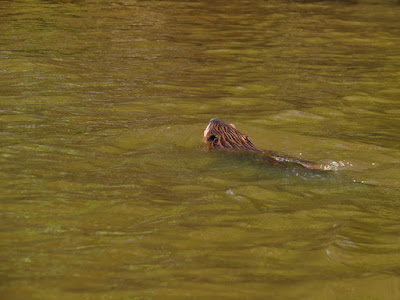I put in on the Mattabesset. The heavy rains up in Vermont, about 2 weeks ago, had sent a huge amount of water down the Connecticut River. The river rose from about 7 ft (Hartford gauge) to 21 ft in just 48 hours. When such events happen, the Mattabesset, which is only 16 miles long, simply fills up, flooding the river bottoms. I've paddled at 15 ft before, a level that allows one to canoe through the bottom land forest as fast as one can slalom through the trees. I missed the twenty foot days, but that would have been paddling through the tree canopy. Today, the river is at 13 ft. The lowest of the forest floors are awash, and while it is enough to float a canoe, it is not deep enough to paddle.
It is about 80 degrees with a thin smeary overcast and a very light breeze out of the south.
The real purpose of coming here today, other than that it is a fine day trip, is to check on the status of the beaver lodges. This river and the Coginchaug, which joins it a short mile above the Connecticut River, have a good number of active beaver colonies. I expect to find all of the lodges abandoned and collapsing.
 |
The site of the Tepee lodges
|
A beaver lodge can tolerate only so much change in water level, say maybe, plus or minus 2 ft. Too little water and the underwater entrances are exposed to predators. Too much water and the living platforms in the lodge are flooded. In fact, this area is tidal and often sees a variation of about 2 ft, twice a day.
The largest of the lodges, which is just a bit up the Coginchaug, had a peak that was about 6 ft above a normal water level. It was about 20ft in diameter at the base, so it was a fairly large lodge. Of course, the flood waters at 20ft would have been 5 or 6 ft over the peak. When something like that happens, the colony leaves and has to find shelter elsewhere. If the flood lasts more than a few days, they will build a new lodge. Here, I've seen them build new bank burrows, which they have to abandon when the water level drops, because the submerged entrances to those new burrows become exposed. And, if the flood lasts long enough, the lodge starts to fall apart. It has been about 2 weeks and the water level is almost down to a normal level.
 |
The remains of the big Coginchaug Lodge
|
On my way down, the first lodge, which was fairly small, is now just a circular pile of sticks, but I spot one beaver in the river nearby. The Tepee Lodge is reduced to a few branches sticking up out of the water. It's actually the second Tepee lodge as the first one, which was just ten feet to the side of it, was flooded out two years ago The big Coginchaug lodge is still conical, but the mud reinforcing has been washed away so it is just a loose heap of branches.
Once the water level is back to normal, the colonies will build new lodges, sometimes right near the old one. The old lodges will continue to collapse. Abandoned lodges often disappear within 2 years.
I head up the Coginchaug to the usual log jam area, about a 1/4 mile above the power lines. I've seen a half dozen Osprey, about the same number of Kingfishers, and a few more than that of Great Blue Herons, and one beaver, of course.































